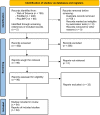Pacing Behaviour Development and Acquisition: A Systematic Review
- PMID: 36484867
- PMCID: PMC9733766
- DOI: 10.1186/s40798-022-00540-w
Pacing Behaviour Development and Acquisition: A Systematic Review
Abstract
Background: The goal-directed decision-making process of effort distribution (i.e. pacing) allows individuals to efficiently use energy resources as well as to manage the impact of fatigue on performance during exercise. Given the shared characteristics between pacing behaviour and other skilled behaviour, it was hypothesized that pacing behaviour would adhere to the same processes associated with skill acquisition and development.
Methods: PubMed, Web of Science and PsycINFO databases between January 1995 and January 2022 were searched for articles relating to the pacing behaviour of individuals (1) younger than 18 years of age, or (2) repeatedly performing the same exercise task, or (3) with different levels of experience.
Results: The search resulted in 64 articles reporting on the effect of age (n = 33), repeated task exposure (n = 29) or differing levels of experience (n = 13) on pacing behaviour. Empirical evidence identifies the development of pacing behaviour starts during childhood (~ 10 years old) and continues throughout adolescence. This development is characterized by an increasingly better fit to the task demands, encompassing the task characteristics (e.g. duration) and environment factors (e.g. opponents). Gaining task experience leads to an increased capability to attain a predetermined pace and results in pacing behaviour that better fits task demands.
Conclusions: Similar to skilled behaviour, physical maturation and cognitive development likely drive the development of pacing behaviour. Pacing behaviour follows established processes of skill acquisition, as repeated task execution improves the match between stimuli (e.g. task demands and afferent signals) and actions (i.e. continuing, increasing or decreasing the exerted effort) with the resulting exercise task performance. Furthermore, with increased task experience attentional capacity is freed for secondary tasks (e.g. incorporating opponents) and the goal selection is changed from achieving task completion to optimizing task performance. As the development and acquisition of pacing resemble that of other skills, established concepts in the literature (e.g. intervention-induced variability and augmented feedback) could enrich pacing research and be the basis for practical applications in physical education, healthcare, and sports.
Keywords: Acquisition; Development; Exercise; Experience; Junior; Pacing; Skill; Sports.
© 2022. The Author(s).
Conflict of interest statement
Stein Menting, Andrew Edwards, Florentina Hettinga and Marije Elferink-Gemser declare that they have no competing interests.
Figures


Similar articles
-
Pacing Decision Making in Sport and the Effects of Interpersonal Competition: A Critical Review.Sports Med. 2018 Aug;48(8):1829-1843. doi: 10.1007/s40279-018-0937-x. Sports Med. 2018. PMID: 29799094 Review.
-
Pacing Behavior Development: The Role of Task Experience and the Presence of Competitors.Med Sci Sports Exerc. 2025 Jan 1;57(1):154-162. doi: 10.1249/MSS.0000000000003538. Epub 2024 Aug 12. Med Sci Sports Exerc. 2025. PMID: 39140775
-
Effects of adding dual-task or sport-specific task constrains to jump-landing tests on biomechanical parameters related to injury risk factors in team sports: a systematic review.PeerJ. 2024 Aug 13;12:e17720. doi: 10.7717/peerj.17720. eCollection 2024. PeerJ. 2024. PMID: 39157766 Free PMC article.
-
The effectiveness of internet-based e-learning on clinician behavior and patient outcomes: a systematic review protocol.JBI Database System Rev Implement Rep. 2015 Jan;13(1):52-64. doi: 10.11124/jbisrir-2015-1919. JBI Database System Rev Implement Rep. 2015. PMID: 26447007
-
Impact of summer programmes on the outcomes of disadvantaged or 'at risk' young people: A systematic review.Campbell Syst Rev. 2024 Jun 13;20(2):e1406. doi: 10.1002/cl2.1406. eCollection 2024 Jun. Campbell Syst Rev. 2024. PMID: 38873396 Free PMC article. Review.
Cited by
-
Effects of the COVID-19 Pandemic on the Performance of Marathon Runners.Transl Sports Med. 2025 Jun 4;2025:9969371. doi: 10.1155/tsm2/9969371. eCollection 2025. Transl Sports Med. 2025. PMID: 40503337 Free PMC article.
-
The perception of time is slowed in response to exercise, an effect not further compounded by competitors: behavioral implications for exercise and health.Brain Behav. 2024 Apr;14(4):e3471. doi: 10.1002/brb3.3471. Brain Behav. 2024. PMID: 38558543 Free PMC article.
-
The Role of Cognition and Social Factors in Competition: How Do People with Intellectual Disabilities Respond to Opponents?Int J Environ Res Public Health. 2023 Feb 2;20(3):2670. doi: 10.3390/ijerph20032670. Int J Environ Res Public Health. 2023. PMID: 36768036 Free PMC article.
-
Graded Mobilization With Pacing Technique for Functional Mobility in a Preoperative Marfan Syndrome Case of Aortic Root Dilation: A Case Report.Cureus. 2024 Feb 20;16(2):e54591. doi: 10.7759/cureus.54591. eCollection 2024 Feb. Cureus. 2024. PMID: 38524030 Free PMC article.
-
The Role of the Social Environment in Pacing and Sports Performance: A Narrative Review from a Self-Regulatory Perspective.Int J Environ Res Public Health. 2022 Dec 2;19(23):16131. doi: 10.3390/ijerph192316131. Int J Environ Res Public Health. 2022. PMID: 36498205 Free PMC article. Review.
References
-
- Edwards A, Polman R. Pacing in sport and exercise: a psychophysiological perspective. New York: Nova Science Publishers; 2012.
Publication types
LinkOut - more resources
Full Text Sources
Research Materials

